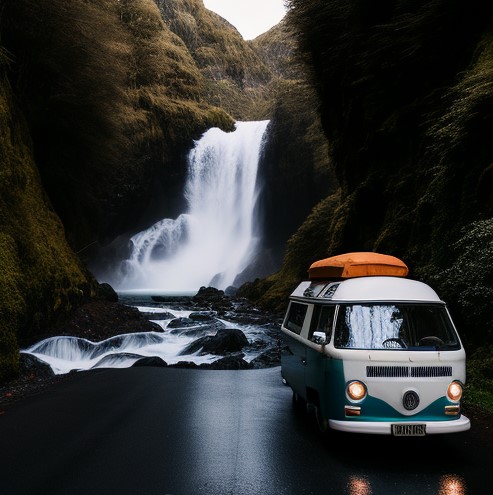“Water, water, everywhere, nor any drop to drink” (Samuel Taylor Coleridge) is not a position you want to find yourself in during your travels.
After choosing your USB tap, water from your onboard plastic tanks can taste different to your household tap water and relying on bottled water for your drinking water comes with its own issues, namely, cost and the environmental impact of all those bottles.
So your next step is to choose a water filter.
If you want the best tasting water from your onboard tanks then yes, you need a water filter in your campervan
In this article, we’ll answer some of the most common questions about campervan water filters, and give you all the information you need to keep your water clean and safe on your next adventure.
Types of Campervan Water Filters
When it comes to choosing a water filter for your campervan, there are a few different options available. The most popular types of campervan water filters are:
- Carbon filters: These filters use activated carbon to remove impurities and improve taste and odor.
- Ceramic filters: These filters use ceramic material to remove bacteria, protozoa, and other impurities.
- Reverse osmosis filters: These filters use a membrane to remove impurities and contaminants.
- UV water purifiers: These devices use ultraviolet light to kill bacteria and viruses.
Each type of filter has its pros and cons, so it’s important to consider your specific needs when choosing a water filter for your campervan.
For example, if you’ll be travelling to remote areas with questionable water sources, a ceramic or reverse osmosis filter may be the best option.
On the other hand, if you’re mainly concerned about taste and odor, a carbon filter may be sufficient.
How often should I change my Campervan Water Filter
Once you’ve chosen a water filter for your campervan, it’s important to keep it in good condition by changing the filter regularly. How often you need to change your campervan water filter will depend on the type of filter you have and how frequently you use it.
Remember to include your filter in your water system cleaning schedule. As a general rule, carbon filters should be changed every 3-6 months, while ceramic filters can last up to a year before needing to be replaced.
Reverse osmosis filters typically need to be changed every 2-3 years, and UV purifiers require a new bulb every 6-12 months. Be sure to check the manufacturer’s instructions for your specific water filter to determine the recommended replacement schedule.
Drinking Water from Your Campervan Filter
If you’re travelling in areas with a safe water supply and you’re mainly worried about the taste of the water then your best choice would be a carbon water filter.
Types of carbon water filter
There are several types of carbon water filters that can be installed in a campervan to improve the quality of drinking water. Here are some of the most common options:
- Inline carbon filter: This type of filter is typically installed directly in the water line that leads to the sink or faucet. The water passes through the filter and the activated carbon absorbs impurities and odors, leaving the water clean and fresh-tasting.
- Countertop carbon filter: A countertop carbon filter is a standalone unit that sits on the countertop and connects to the campervan’s water supply with a hose or adapter. Water is poured into the top of the unit and passes through the carbon filter before being dispensed from the spout.
- Gravity-fed carbon filter: A gravity-fed carbon filter is a portable option that can be used both inside and outside the campervan. Water is poured into the top of the unit and gravity pulls it through the filter. This type of filter is ideal for camping trips or situations where access to clean drinking water is limited.
Most self built campervans choose to have an inline filter installed between the tank and the tap.
How to fit an inline carbon water filter
Here are step-by-step instructions for fitting an inline carbon water filter in a campervan:
- Gather your materials: You will need an inline carbon water filter, a wrench, Teflon tape, and a bucket or towel to catch any water that may spill during the installation.
- Turn off the water supply: Locate the water shut-off valve that controls the water supply to the sink or faucet where you want to install the filter. Turn off the valve to stop the flow of water.
- Determine the best location for the filter: The filter should be installed on the cold water line leading to the sink or faucet. Look for a straight section of pipe with at least 6 inches of clearance on both sides.
- Cut the pipe: Use a pipe cutter or hacksaw to cut the cold water line at the chosen location. Make a clean, straight cut to ensure a tight seal.
- Install the fittings: Attach the fittings included with the filter to the cut ends of the pipe. Apply Teflon tape to the threads of the fittings to create a watertight seal. Use a wrench to tighten the fittings securely.
- Install the filter: Attach the filter to the fittings. Make sure the arrow on the filter housing is pointing in the direction of water flow. Tighten the filter housing securely by hand.
- Turn on the water supply: Slowly turn on the water supply valve to restore water flow. Check for leaks at the fittings and around the filter housing. Tighten any connections that are leaking.
- Flush the filter: Turn on the faucet and let the water run for several minutes to flush the filter and remove any carbon dust or debris. The water may initially appear cloudy but should clear up after a few minutes of flushing.
- Test the water: Once the filter has been flushed, fill a glass with water from the faucet and taste it to ensure that the filter is working properly. The water should be clean and fresh-tasting.
Following these steps should allow you to successfully install an inline carbon water filter in your campervan and enjoy clean, safe drinking water on the road.
Differences between house and van installation of inline carbon water filters
There are several differences between installing an inline carbon water filter in a house and installing one in a campervan.
- Space: In a house, there is generally more space available for installing a water filter, while in a campervan, space is often at a premium. This means that the water filter chosen for a campervan needs to be compact and designed specifically for use in a small space.
- Flow rate: The flow rate of water in a campervan is usually much lower than in a house, which means that the water filter chosen for a campervan needs to have a lower flow rate and be able to work effectively at lower pressure.
- Mobility: A campervan is designed to be mobile and may be subject to vibrations, jolts, and changes in temperature that could affect the performance of a water filter. Therefore, the water filter chosen for a campervan needs to be durable, sturdy, and able to withstand such conditions.
- Maintenance: The maintenance of a water filter in a campervan is different from that in a house. In a campervan, the water filter needs to be easy to access and replace, and the replacement cartridges need to be small and lightweight enough to store in the limited space available.
Overall, while there are some similarities between installing an inline carbon water filter in a house and a campervan, there are also several key differences that need to be taken into account to ensure the filter works effectively and efficiently in each environment.
What is the Difference Between Water Filters and Water Purifiers
While water filters and water purifiers are often used interchangeably, there is a difference between the two. Water filters are designed to remove impurities and improve taste and odor, while water purifiers are designed to remove or kill bacteria, viruses, and other contaminants.
If you’re travelling to areas with questionable water sources, it may be wise to invest in a water purifier in addition to a water filter. UV purifiers, for example, use ultraviolet light to kill bacteria and viruses, making the water safe to drink.
However, keep in mind that water purifiers may not remove all impurities, so it’s important to do your research and choose a product that fits your needs.
Hopefully this article has answered some of your questions about campervan water filters and given you the information you need to choose and maintain the right filter for your next adventure.
Remember, clean and safe water is essential when living on the road, so don’t skimp on this important aspect of campervan life!
AFFILIATE DISCLAIMER
The USBWOW website is supported by our visitors. Some of the product links on this website are through affiliate schemes such as Amazon. This means that I earn a small commission if you choose to purchase something at no extra cost to yourself.

